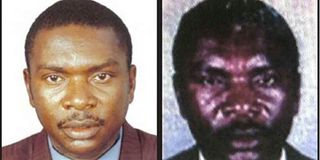2 key Rwanda genocide fugitives dead, investigators focus on four others

This undated handout combination of pictures released by The United Nations - International Residual Mechanism for Criminal Tribunals (MICT) shows Protais Mpiranya who commanded the guard of Rwanda's former president Juvenal Habyarimana. PHOTOS | MICT | AFP
What you need to know:
- Fugitive Protais Mpiranya died in Zimbabwe in 2006, while Pheneas Munyarugarama succumbed in DR Congo in 2002, UN prosecutors investigating their cases have said.
The two were accused of genocide, war crimes and crimes against humanity in relation to the roles they played in the mass murder of the Tutsi minority by the Hutus.
During the genocide, Mpiranya was head of the presidential guard and was accused of ordering the murder of the then Prime Minister Agathe Uwilingiyimana.
The 20-year hunt for two masterminds of the 1994 Rwandan genocide has ended at graveyards in Zimbabwe and the Democratic Republic of Congo.
Fugitive Protais Mpiranya died in Zimbabwe in 2006, while Pheneas Munyarugarama succumbed in DR Congo in 2002, UN prosecutors investigating their cases have said.
The two were accused of genocide, war crimes and crimes against humanity in relation to the roles they played in the mass murder of the Tutsi minority by the Hutus.
During the genocide, Mpiranya was head of the presidential guard and was accused of ordering the murder of the then Prime Minister Agathe Uwilingiyimana.
According to his indictment, he had given his men a kill list of prominent Tutsis and orders to kill their families. He armed and trained the notorious Interahamwe Hutu militia responsible for thousands of deaths.
His officers also murdered the 10 Belgian UN peacekeepers guarding Ms Uwilingiyimana.
The body of Mpiranya, who dies on October 5, 2006, was found buried in Harare under a stone slab bearing a false name, which UN investigators tracked down and identified with the help of a critical lead found on a confiscated computer: the hand-drawn design for Mpiranya’s tombstone.
On May 10, Mpiranya’s identity was confirmed by DNA analysis after his body was exhumed last month at the request of investigators working with Mechanism for International Criminal Tribunals (MICT).
Serge Brammertz, the UN prosecutor who led the hunt, said Mpirinya was the last of the major fugitives, and finding his body “provides the solace of knowing that he cannot cause further harm.”
“With the confirmation of Protais Mpiranya’s death last Thursday, [and now Phénéas Munyarugarama’s this Wednesday) only four fugitives remain under the jurisdiction of the Mechanism: Fulgence Kayishema, Charles Sikubwabo, Charles Ryandikayo and Aloys Ndimbati,” Mr Brammertz said on Wednesday.
The prosecutor added that his number one priority is Fulgence Kayishema, whom he says is believed to be living in South Africa.
Munyarugarama, a former military officer in Rwanda, was indicted by the International Criminal Tribunal for Rwanda (ICTR) in February 2002.
The ICTR charged him with eight counts, including genocide, direct and public incitement to commit genocide and crimes against humanity.
Munyarugarama was held responsible for massacres, attacks and sexual violence against Tutsi civilians in Bugesera region, including attacks on Tutsi refugees in Catholic churches at the height of the Rwandan Genocide against the Tutsi. He held the rank of lieutenant-colonel.
Munyarugarama fled Rwanda in June 1994 to the DRC, then called Zaire.
He was joined the former Rwandan Armed Forces and later the Democratic Forces for the Liberation of Rwanda (FDLR), the rebels opposed to Kigali.
“Following a difficult and intense investigation, the Office of the Prosecutor was able to determine that Munyarugarama died of natural causes on or about 28 February 2002 in Kankwala, in the eastern provinces of the Democratic Republic of Congo, where he was also buried,” the May 18 statement said.
Accused of genocide, crimes against humanity, and war crimes, Mpiranya was a key remaining wanted figure following the arrest of Felicien Kabuga in France two years ago.
He was accused, along with others, of having instigated the killing of the moderate Hutu Prime Minister Agathe Uwilingiyimana on April 7, 1994.
After an indictment was issued against him, Mpiranya fled to Zimbabwe in late 2002, where he lived until his death in 2006, the tribunal said.
The investigation found he had arrived on a Zimbabwean military plane and had been in frequent contact during his stay with Zimbabwean officials in the then President Robert Mugabe's regime, who were well aware of his identity as a valued ally in the second Congo war of 1998-2003.
“Mpiranya's presence in Zimbabwe, and later the fact of his death, were deliberately concealed by the concerted efforts of his family and associates, including up to the present,” the MICT said, adding it would ask judges to close the case.
The mass killing of Rwanda's Tutsi population was ignited on April 6, when a plane carrying President Juvénal Habyarimana was shot down and crashed in Kigali, the capital, killing the leader who was an ethnic Hutu.
The Tutsi were blamed for downing the plane, and although they denied it, bands of Hutu extremists began killing them, including children.





